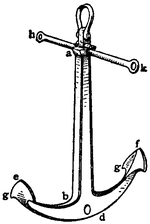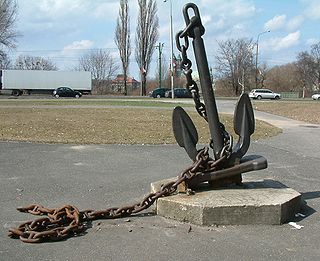
An anchor is a device, normally made of metal, used to secure a vessel to the bed of a body of water to prevent the craft from drifting due to wind or current. The word derives from Latin ancora, which itself comes from the Greek ἄγκυρα.

A forge is a type of hearth used for heating metals, or the workplace (smithy) where such a hearth is located. The forge is used by the smith to heat a piece of metal to a temperature at which it becomes easier to shape by forging, or to the point at which work hardening no longer occurs. The metal is transported to and from the forge using tongs, which are also used to hold the workpiece on the smithy's anvil while the smith works it with a hammer. Sometimes, such as when hardening steel or cooling the work so that it may be handled with bare hands, the workpiece is transported to the slack tub, which rapidly cools the workpiece in a large body of water. However, depending on the metal type, it may require an oil quench or a salt brine instead; many metals require more than plain water hardening. The slack tub also provides water to control the fire in the forge.
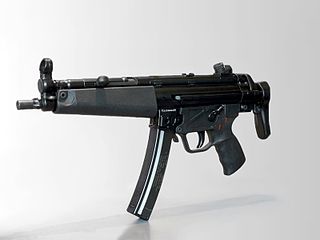
The Heckler & Koch MP5 is a submachine gun developed in the 1960s by German firearms manufacturer Heckler & Koch. It uses a similar modular design to the Heckler & Koch G3, and has over 100 variants and clones, including selective fire, semi-automatic, suppressed, compact, and even marksman variants. The MP5 is one of the most widely used submachine guns in the world, having been adopted by over forty nations and numerous militaries, police forces, intelligence agencies, security organizations, paramilitaries, and non-state actors.
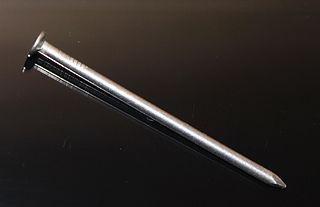
In woodworking and construction, a nail is a small object made of metal which is used as a fastener, as a peg to hang something, or sometimes as a decoration. Generally, nails have a sharp point on one end and a flattened head on the other, but headless nails are available. Nails are made in a great variety of forms for specialized purposes. The most common is a wire nail. Other types of nails include pins, tacks, brads, spikes, and cleats.
A saw is a tool consisting of a tough blade, wire, or chain with a hard toothed edge used to cut through material. Various terms are used to describe toothed and abrasive saws.

Boat building is the design and construction of boats — and their on-board systems. This includes at minimum the construction of a hull, with any necessary propulsion, mechanical, navigation, safety and other service systems as the craft requires.
The Accuracy International Arctic Warfare rifle is a bolt-action sniper rifle designed and manufactured by the British company Accuracy International. It has proved popular as a civilian, police, and military rifle since its introduction in the 1980s. The rifles have features that improve performance in extremely cold conditions without impairing operation in less extreme conditions.

Kyrenia is a 4th-century BC ancient Greek merchant ship that sank c. 294 BC.

An eye bolt is a bolt with a loop at one end. They are used to firmly attach a securing eye to a structure, so that ropes or cables may then be tied to it.
The Savage Model 110 is a bolt-action repeating rifle made by Savage Arms. It was designed in 1958 by Nicholas L. Brewer. It was patented in 1963 and has been in continuous production since that time. The model variants included the first left-handed rifle to be made "in volume" by a major firearms manufacturer.
TrentonWorks is an industrial manufacturing facility located in the town of Trenton, Nova Scotia, Canada.

A cathead is a large wooden beam located on either side of the bow of a sailing ship, and angled forward at roughly 45 degrees. The beam is used to support the ship's anchor when raising it or lowering it, and for carrying the anchor on its stock-end when suspended outside the ship's side. The cathead is furnished with sheaves at the outer end, and the inner end fits down on the cat-beam. The shank painter is a short rope or chain by which the shank of an anchor is held fast to a ship's side when not in use. The process of securing the anchor is called catting and fishing it. The cat stopper also fastens the anchor on. The purpose of the cathead is to provide both a heavy enough beam to support the massive weight of the anchor, and to hold the metal anchor away from the wooden side of the ship to prevent damage when the anchor is being raised from the water. The stockless anchor made the cathead obsolete.

A screw is an externally helical threaded fastener capable of being tightened or released by a twisting force (torque) to the head. The most common uses of screws are to hold objects together and there are many forms for a variety of materials. Screws might be inserted into holes in assembled parts or a screw may form its own thread. The difference between a screw and a bolt is that the latter is designed to be tightened or released by torquing a nut.

A rail fastening system is a means of fixing rails to railroad ties or sleepers. The terms rail anchors, tie plates, chairs and track fasteners are used to refer to parts or all of a rail fastening system. The components of a rail fastening system may also be known collectively as other track material, or OTM for short. Various types of fastening have been used over the years.

A bolt is an externally helical threaded fastener that fastens objects with unthreaded holes together. This is done by applying a twisting force (torque) to a matching nut. The bolt has an external male thread requiring a matching nut with a pre-formed female thread. Unlike a screw, which holds objects together by the restricting motion parallel to the axis of the screw via the normal and frictional forces between the screw's external threads and the internal threads in the objects to be fastened, a bolt prevents that linear motion via the frictional and normal forces between the bolt's external threads and the internal threads of the matching nut, which can be tightened by applying a torque which moves the nut linearly along the axis of the bolt and compresses the objects to be fastened.

A boomkin, bumkin, or bumpkin is a short spar that may project either fore or aft on a sailing vessel, depending on its function. Traditionally, it was a strong, usually wooden spar extending forward over the bow of a Western sailing ship holding a block through which the tack of the foresail was passed; on some modern sailing yachts with long main booms it is a short spar extending aft from the stern anchoring a central backstay.
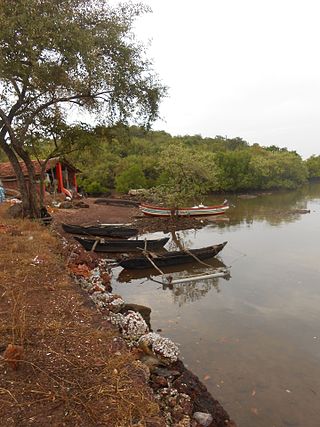
Rameshwar Dockyard also known as Rameshwar Godi (Marathi) is a small tidal dockyard located on the west bank of Waghotan River of Sindhudurg District of Maharashtra state on the west coast of India. It is a naval dockyard built by the Maratha Admiral Kanhoji Angre about 1.5 km from Vijaydurg Fort, used mainly for repair and maintenance of ships of the Maratha Navy. The dockyard currently lies on the outskirts of a small Christian Settlement and is used only for the purpose of fishing.

A stockless anchor is a streamlined derivation of the traditional Admiralty anchor used aboard large ships. Patented in England in 1821, it eliminated the stock of the Admiralty, making it both easier to handle and stow. Though it did not hold as well as an Admiralty, the trade-off proved acceptable and the stockless anchor became widely popular, and it remains so.

Offshore embedded anchors are anchors intended for offshore use that derive their holding capacity from the frictional, or bearing, resistance of the surrounding soil, as opposed to gravity anchors, which derive their holding capacity largely from their weight. As offshore developments move into deeper waters, gravity-based structures become less economical due to the large size needed and the consequent cost of transportation.
This glossary of nautical terms is an alphabetical listing of terms and expressions connected with ships, shipping, seamanship and navigation on water. Some remain current, while many date from the 17th to 19th centuries. The word nautical derives from the Latin nauticus, from Greek nautikos, from nautēs: "sailor", from naus: "ship".

